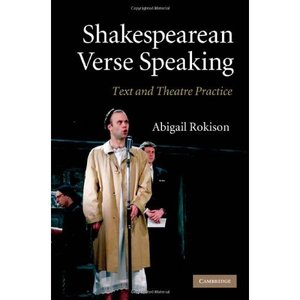 Cambridge Professor Abigail Rokison has recently been awarded the Shakespeare’s Globe Book Award, an honour I think she deserves considering this woman questioned the way Shakespearean text is translated into a performance by the most distinguished theatre companies in the U.K.
Cambridge Professor Abigail Rokison has recently been awarded the Shakespeare’s Globe Book Award, an honour I think she deserves considering this woman questioned the way Shakespearean text is translated into a performance by the most distinguished theatre companies in the U.K.
My interest in this subject began when I first learned how to breathe at the end of a verse line in my junior Shakespeare acting class at Cal State Fullerton (2005), taught by Evelyn Carol Case. Professor Case often attended workshops by the RSC and always brought back their wisdom to us sunny Californians. The archaic language and various poetic elements frighten most actors who perform Shakespeare, which can inhibit them from delivering their lines effectively and with meaning. So anyone who is able to give advice on the subject is usually welcome (or as Rokison said clung to like a drowning man clinging to a rock).
Over the centuries, there have been many ways of interpreting Shakespeare’s text for the stage, and most of it’s history is bound up in how scholars edited the texts that were printed and read in book form. What has been the most recent approach, the one that I was taught at university, and in a Central School of Drama Shakespeare acting class (attended in the fall of 2010), is a fidelity to the earliest texts in existence, the folios and the quartos. It was thought that since there were no directors in Shakespeare’s day, there were hidden clues in the text that helped the actors interpret their lines. That means every short line, every punctuation, every extra syllable MEANT SOMETHING. The best example I can give of this is a line from Twelfth Night spoken by Olivia to Viola (disguised as Cesario) about her feeling for the Duke:
Your lord does know my mind, I cannot love him.
(Act I, Scene V, Arden Shakespeare, 2005)
Shakespeare wrote in iambic pentameter meaning there should be ten syllables in a line with a dah-dum stress . There is an extra syllable in this line, ‘him,’ which could be emphasised or de-emphasised, and suggests that Olivia may already be falling for Viola’s disguise. This extra syllable would probably be noted by the director or actor and used to interpret movement or delivery on stage.
The irony in this method is that such intense analysis of the script implies that theatre makers are working from a solid stable text, when in actuality, there couldn’t be a more unstable text than Shakespeare’s. Controversy surrounding the playwright is not limited to the authorial debate. It also resides in the fact that there are hardly any extant play scripts, that actors used roles which only had their own lines (and parts of the character speaking before them), and that the scribes who copied Shakespeare’s papers were probably very lazy and/or sought their own ways of improving the texts, leading to a lot of tampering before the text even made it to the print house.
This is where Rokison’s work comes into play. Her monograph questions the idea that theatre practitioners can make a set of rules that actors should abide by, especially when they are centred on texts that cannot necessarily pinpoint why things like a period (fullstop) is placed where it is, if it is in fact the author that put it there, or the scribe, or one of many (many MANY) editors. Rokison backs up her challenge with evidence from early text versions of nine Shakespeare plays that span his career, analysing how shared and short lines, end-stopping and enjambment might suggest specific ways to deliver a line. What Rokison looks for is a clear pattern that will validate the rules that theatre makers have stressed over the last decade. What becomes exceedingly clear through her research is no pattern actually exists. That isn’t to say that what theatre makers preach doesn’t have any bearing. I think (and Rokison would probably agree) that their methods are probably based more on empirical evidence, which is completely valid in judging what is an effective way to interpret a character’s actions and less on what Shakespeare had to say on the matter. I found Shakespearean Verse Speaking answered a lot of questions I had on how (western) actors today interpret their parts, where their methods come from, and how much faith one should hold in what professed experts say on the matter. It is inspiring to know that there are several diverse ways to perform Shakespeare and all of them can be equally valid according to the time and the place.
Rokison’s book has emerged in a time where more and more scholars are looking at the stage history of the plays, and working more with theatre practitioners to create editions of the plays that encourage performance instead of solely focussing on literary analysis. I think her publication is a great step in marrying these two worlds.